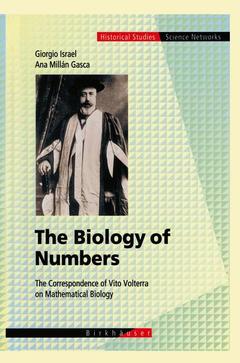The Biology of Numbers, Softcover reprint of the original 1st ed. 2002 The Correspondence of Vito Volterra on Mathematical Biology Science Networks. Historical Studies Series, Vol. 26
Langue : Anglais
Auteurs : Israel Giorgio, Gasca Ana M.

Foreword The modern developments in mathematical biology took place roughly between 1920 and 1940, a period now referred to as the "Golden Age of Theoretical Biology". The eminent Italian mathematician Vito Volterra played a decisive and widely acknowledged role in these developments. Volterra's interest in the application of mathematics to the non physical sciences, and to biology and economics in particular, dates back to the turn of the century and was expressed in his inaugural address at the University of Rome for the academic year 1900/01 (VOLTERRA 1901). Nevertheless, it was only in the mid-twenties that Volterra entered the field in person, at the instigation of his son in law, Umberto D'Ancona, who had confronted him with the problem of competition among animal species, asking him whether a mathematical treatment was possible. From that time on, until his death in 1940, Volterra produced a huge output of publications on the subject. Volterra's specific project was to transfer the model and the concepts of classical mechanics to biology, constructing a sort of "rational mechanics" and an "analytic mechanics" of biological associations. The new subject was thus to be equipped with a solid experimental or at least empirical basis, also in this case following the tried and tested example of mathematical physics. Although very few specific features of this reductionist programme have actually survived, Volterra's contribution was decisive, as is now universally acknowledged, in en couraging fresh studies in the field of mathematical biology.
1 Mathematical Theories versus Biological Facts: A Debate on Mathematical Population Dynamics in the 30s (A. Millán Gasca) 1.- Correspondence.- 2 Vito Volterra.- 3 Presentation of the Correspondence.- 4 Letters between Marcel Brelot and Vito Volterra.- 5 Letters between Royal N. Chapman and Vito Volterra.- 6 Letters between Umberto D’Ancona and Vito Volterra.- 7 Letters between Charles S. Elton and Vito Volterra.- 8 Letter between Karl Friederichs and Vito Volterra.- 9 Letters between Georgii F. Gause and Vito Volterra.- 10 Letters between Samuel A. Graham and Vito Volterra.- 11 Letters between William O. Kermack and Vito Volterra.- 12 Letters between Vladimir A. Kostitzin and Vito Volterra.- 13 Letters between Joseph Larmor and Vito Volterra.- 14 Letters between Alfred J. Lotka and Vito Volterra.- 15 Letters between Edouard Monod-Herzen and Vito Volterra.- 16 Letters between Raymond Pearl and Vito Volterra.- 17 Letters between Karl Pearson and Vito Volterra.- 18 Letters between Jean Régnier and Vito Volterra.- 19 Letters between John Stanley and Vito Volterra.- 20 Letters between Georges Teissier and Vito Volterra.- 21 Letters between D’Arcy W. Thompson and Vito Volterra.- 22 Letters between William R. Thompson and Vito Volterra.- 23 Catalogue of Letters.- 24 References.
The present book is an exhaustive collection of the correspondence between Vito Volterra and numerous scientists on the topic of Mathematical Biology. At the end of the book seventeen pages of very useful references are given. The book is useful to those who are working in the field of Mathematical Biology as well as History of Mathematical Biology.-Zentralblatt Math"We first meet Volterra on the front cover of the book under review. There he is: a magnificent, full-bearded and moustached figure in full academic regalia, shown perhaps in his mid-fifties. Vito Volterra, 1860-1940, professor at the University of Rome, president of the renowned Accademia dei Lincei, member of the Royal Society, recipient of other honors too numerous to mention, scion of an Italian Jewish family whose genealogy has been traced back to the early 1400s. A crater on the Moon has been named after him.... Reading the letters [in the book]...gives an idea of Volterra's extensive scientific contacts. More importantly, it gives an idea of the birth pangs of a relatively new and problematic application of mathematics. You will get whiffs of the struggles between the deterministic and the probabilistic approaches, between continuous and discrete models, among models in either category, between holistic (empirical and experimental) and mathematical approaches, between closed-form solutions and numerical solutions, between the qualitative and the quantitative. You will also read about the struggle between the realists and the idealists as regards what the goal of inquiry should be. Gasca's [54-page] introduction [to the book and history of the early (1920s and 30s) development of population dynamics] fleshes out these various antagonisms."-SIAM News
Ouvrage de 405 p.
15.5x23.5 cm
Ouvrage de 405 p.
15.5x23.5 cm
Thème de The Biology of Numbers :
© 2024 LAVOISIER S.A.S.



